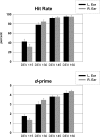Right Hemispheric Contributions to Fine Auditory Temporal Discriminations: High-Density Electrical Mapping of the Duration Mismatch Negativity (MMN)
- PMID: 19430594
- PMCID: PMC2679157
- DOI: 10.3389/neuro.07.005.2009
Right Hemispheric Contributions to Fine Auditory Temporal Discriminations: High-Density Electrical Mapping of the Duration Mismatch Negativity (MMN)
Abstract
That language processing is primarily a function of the left hemisphere has led to the supposition that auditory temporal discrimination is particularly well-tuned in the left hemisphere, since speech discrimination is thought to rely heavily on the registration of temporal transitions. However, physiological data have not consistently supported this view. Rather, functional imaging studies often show equally strong, if not stronger, contributions from the right hemisphere during temporal processing tasks, suggesting a more complex underlying neural substrate. The mismatch negativity (MMN) component of the human auditory evoked-potential provides a sensitive metric of duration processing in human auditory cortex and lateralization of MMN can be readily assayed when sufficiently dense electrode arrays are employed. Here, the sensitivity of the left and right auditory cortex for temporal processing was measured by recording the MMN to small duration deviants presented to either the left or right ear. We found that duration deviants differing by just 15% (i.e. rare 115 ms tones presented in a stream of 100 ms tones) elicited a significant MMN for tones presented to the left ear (biasing the right hemisphere). However, deviants presented to the right ear elicited no detectable MMN for this separation. Further, participants detected significantly more duration deviants and committed fewer false alarms for tones presented to the left ear during a subsequent psychophysical testing session. In contrast to the prevalent model, these results point to equivalent if not greater right hemisphere contributions to temporal processing of small duration changes.
Keywords: auditory temporal resolution; event-related potentials; hemispheric asymmetry.
Figures





References
Grants and funding
LinkOut - more resources
Full Text Sources

